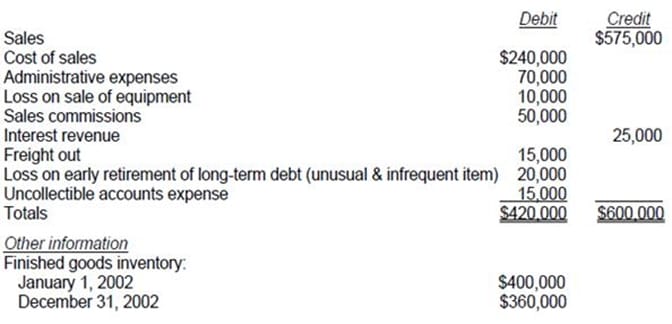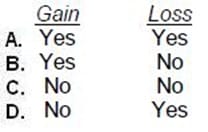Exam Details
Exam Code
:CPA-TESTExam Name
:Certified Public Accountant Test: Auditing and Attestation, Business Environment and Concepts, Financial Accounting and Reporting, RegulationCertification
:AICPA CertificationsVendor
:AICPATotal Questions
:1241 Q&AsLast Updated
:Jun 30, 2025
AICPA AICPA Certifications CPA-TEST Questions & Answers
-
Question 181:
The following question is based on the following:
ABC Co.'s trial balance of income statement accounts for the year ended December 31, 2002, included the
following:

ABC's income tax rate is 30%.
In ABC's 2002 multiple-step income statement, what amount should ABC report as income from continuing
operations?
A. $126,000
B. $129,500
C. $140,000
D. $147,000
-
Question 182:
The effect of a material transaction that is infrequent in occurrence but not unusual in nature should be presented separately as a component of income from continuing operations when the transaction results in
a:
A.
Option A
B.
Option B
C.
Option C
D.
Option D

-
Question 183:
ABC Corp. failed to accrue warranty costs of $50,000 in its December 31, 1992, financial statements. In addition, a $30,000 change from straight-line to accelerated depreciation was made at the beginning of 1993. Both the $50,000 and the $30,000 are net of related income taxes. What amount should ABC report as prior period adjustments in 1993?
A. $0
B. $30,000
C. $50,000
D. $80,000
-
Question 184:
How should the effect of a change in accounting estimate be accounted for?
A. By restating amounts reported in financial statements of prior periods.
B. By reporting pro forma amounts for prior periods.
C. As a prior period adjustment to beginning retained earnings.
D. In the period of change and future periods if the change affects both.
-
Question 185:
A transaction that is unusual in nature and infrequent in occurrence should be reported separately as a component of income:
A. After cumulative effect of accounting changes and before discontinued operations of a segment of a business.
B. After cumulative effect of accounting changes and after discontinued operations of a segment of a business.
C. Before cumulative effect of accounting changes and before discontinued operations of a segment of a business.
D. After discontinued operations of a segment of a business.
-
Question 186:
During 1994, ABC Corp. decided to change from the FIFO method of inventory valuation to the
weightedaverage method. Inventory balances under each method were as follows:

ABC's income tax rate is 30%.
ABC should report the cumulative effect of this accounting change as a(n):
A. Adjustment to beginning retained earnings.
B. Component of income from continuing operations.
C. Extraordinary item.
D. Component of income after extraordinary items.
-
Question 187:
A material loss should be presented separately as a component of income from continuing operations when it is:
A. An extraordinary item.
B. A cumulative effect type change in accounting principle.
C. Unusual in nature and infrequent in occurrence.
D. Not unusual in nature but infrequent in occurrence.
-
Question 188:
ABC Co. changed from the cash basis of accounting to the accrual basis of accounting during 1994. The cumulative effect of this change should be reported in ABC's 1994 financial statements as a:
A. Prior period adjustment resulting from the correction of an error.
B. Prior period adjustment resulting from the change in accounting principle.
C. Component of income before extraordinary item.
D. Component of income after extraordinary item.
-
Question 189:
In open market transactions, ABC Corp. simultaneously sold its long-term investment in XYZ Corp. bonds and purchased its own outstanding bonds. The broker remitted the net cash from the two transactions. ABC's gain on the purchase of its own bonds exceeded its loss on the sale of the XYZ bonds. Assume the transaction to purchase its own outstanding bonds is unusual in nature and has occurred infrequently. ABC should report the:
A. Net effect of the two transactions as an extraordinary gain.
B. Net effect of the two transactions in income before extraordinary items.
C. Effect of its own bond transaction gain in income before extraordinary items, and report the Iron bond transaction as an extraordinary loss.
D. Effect of its own bond transaction as an extraordinary gain, and report the XYZ bond transaction loss in income before extraordinary items.
-
Question 190:
In April 30, 20X4, ABC Corp. approved a plan to dispose of a component of its business. For the period January 1 through April 30, 20X4, the component had revenues of $500,000 and expenses of $800,000. The assets of the component were sold on October 15, 20X4 at a loss. In its income statement for the year ended December 31, 20X4, how should ABC report the component's operations from January 1 to April 30, 20X4?
A. $500,000 and $800,000 should be included with revenues and expenses, respectively, as part of continuing operations.
B. $300,000 should be reported as part of the loss on disposal of a component and included as part of continuing operations.
C. $300,000 should be reported as an extraordinary loss.
D. $300,000 should be reported as a loss from operations of a component and included in loss from discontinued operations.
Tips on How to Prepare for the Exams
Nowadays, the certification exams become more and more important and required by more and more enterprises when applying for a job. But how to prepare for the exam effectively? How to prepare for the exam in a short time with less efforts? How to get a ideal result and how to find the most reliable resources? Here on Vcedump.com, you will find all the answers. Vcedump.com provide not only AICPA exam questions, answers and explanations but also complete assistance on your exam preparation and certification application. If you are confused on your CPA-TEST exam preparations and AICPA certification application, do not hesitate to visit our Vcedump.com to find your solutions here.
